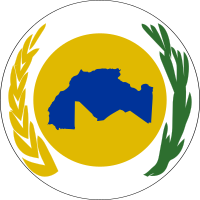Union of the Arab Maghreb
| Union of the Arab Maghreb UAM |
|
|---|---|
 Member States |
|
| French name | Union du Maghreb arabe |
| Arabic name | اتحاد المغرب العربي Ittihād al-Maghrib al-ʿarabī |
| Organization type | Regional economic and political cooperation |
| Seat of the organs | Rabat ( Morocco ) |
| Chair | changing annually |
| Secretary General | Taieb Baccouche since May 5, 2016 |
| Parliamentary Assembly | Tunis ( Tunisia ) |
| Member States | |
| Official and working languages | |
| surface | 6,041,261 km² |
| population | 97,374,932 (June 2017) |
| Population density | 16.1 inhabitants per km² |
| gross domestic product | US $ 430.4 billion (2013 estimate) |
| Gross domestic product per inhabitant | US $ 7,424 (2013 estimate) |
| founding | |
| Currencies | |
| Time zone | UTC ± 0 to UTC + 1 |
| www.maghrebarabe.org | |
The Union of the Arab Maghreb ( UAM , French Union du Maghreb arabe ; Arabic اتحاد المغرب العربي Ittihād al-Maghrib al-ʿarabī , DMG Ittiḥād al-Marġrib al-ʿarabī 'Union of the Arab Maghreb') is an inter-Arab agreement with the aim of economic union and coordinated politics in North Africa .
aims
The Union's goals are economic cooperation as well as foreign, domestic and cultural policy cooperation. Numerous regional projects, some of which had been planned for a long time, such as the expansion of transmaghrebian rail, road and pipeline connections, could be advanced. Other activities concerned the preservation of the spiritual and moral values of Islam and the safeguarding of the Arab identity, among other things through professor and student exchange programs as well as joint university and cultural institutes.
history
Idea and foundation
The idea for an economic community in the Maghreb began with the independence of Tunisia and Morocco in 1956 . Negotiations for economic integration have also been conducted with Algeria and Libya since 1964 . On March 9, 1966, Algeria , Libya , Morocco and Tunisia agreed to set up a permanent secretariat based in Tunis , a consultative committee on economic issues, and a joint committee on postal and telecommunications. After the revolution in Libya (1969), the conflicts between the individual member states initially increased; Libya initially withdrew from the common market in 1970 .
It took another twenty years before the five states Algeria, Libya, Mauritania , Morocco and Tunisia met for their first Maghreb summit . A year later, on February 17, 1989 , the agreement was formally signed by the member states in Marrakech . The presidency of the Union rotates annually between the individual states.
Economic Integration Roadmap
In 1991 a roadmap for the economic integration of the region, which should lead to an economic union, was adopted by all member states. The revitalization of the Maghreb Union threatens to fail because a permanent normalization of the Moroccan-Algerian relationship, which is still very tense due to the Western Sahara conflict, is still a long way off .
A union of the Maghreb states is of topical importance from the point of view of the European Union and enlightened circles in the Maghreb itself because of the refugee flows from the southern African states that entered public awareness again in summer 2005 . In Morocco, in particular, there is hope that the conference of EU states and numerous Mediterranean countries held in Barcelona in 1995, which will continue from November 27 to 29, 2005, will give new impetus to the creation of a free trade area for the southern and eastern Mediterranean countries.
The exchange of trade between the individual Maghreb states remained low: Algeria only conducts 1.5 percent of its foreign trade with the UAM, but over 60 percent with the EU. Tunisia, as the country most strongly oriented towards the Maghreb, is only six percent (75 percent with the EU) (data from 2000).
Problems
Problems of the UAM in the implementation are the different legislations of the member states, the cumbersome bureaucracy, the low exchange of goods between each other (only three percent of total exports) and a lack of financial resources. A customs union has not yet been established.
In addition, protracted disputes between Morocco and Algeria have been blocking the meeting since the early 1990s because of the unresolved Western Sahara issue, despite various attempts to restart the meeting. A meeting in mid-2005 failed due to Morocco's refusal to attend. Algeria had previously spoken out openly in support of the independence of Western Sahara.
Member States
-
 Algeria (1989)
Algeria (1989) -
 Libya (1989)
Libya (1989) -
 Mauritania (1989)
Mauritania (1989) -
 Morocco (1989)
Morocco (1989) -
 Tunisia (1989)
Tunisia (1989)
All participating countries are also members of the Arab League and the African Union .
In May 1989 Libya's revolutionary leader Gaddafi invited the Sahel states of Sudan, Chad, Mali and Niger to join the union.
See also
Web links
- The Arab Maghreb Union on Libya.com
- Official website (Arabic, English, French)
- Federal Agency for Civic Education : Regional Cooperation and Integration
Individual evidence
- ↑ Nadia Lamlili: Tunisie: Taieb Baccouche, nouveau secrétaire général de l'UMA. In: Jeune Afrique , May 5, 2016 (French).
- ↑ https://www.cia.gov/library/publications/the-world-factbook/rankorder/2119rank.html


